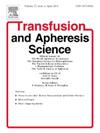Case report of anti-f(ce) antibody identified with unknown autoantibody from ABO discrepancy in a patient with liver cell carcinoma
IF 1.4
4区 医学
Q4 HEMATOLOGY
引用次数: 0
Abstract
The Rh blood type has 57 antigens, including D, C, E, c, and e. This blood type is clinically significant, alongside the ABO blood type. The anti-f(ce) antibody is an unexpected antibody that targets an antigen composed of the c and e antigens. We would like to report a case of the anti-f(ce) antibody discovered during an investigation of an ABO discrepancy. A 63-year-old man diagnosed with liver cell carcinoma was hospitalized for endoscopic variceal ligation due to esophageal varix. To prepare for the possibility of transfusion during the procedure, an ABO blood type test was conducted, resulting in B and O in cells and serum/plasma typing, respectively. The unexpected antibody identification test revealed the presence of the anti-f(ce) antibody. The Rh phenotype of the B cells used in the ABO serum/plasma typing test was determined to be ce. The anti-f(ce) antibody present in the patient’s serum reacted with the B cells in the ABO serum/plasma typing test. To our knowledge, this is the first report of anti-f(ce) causing ABO discrepancy in Korea, and only the second reported case worldwide. We hope that our case report on the identification of the rare anti-f(ce) antibody from an ABO discrepancy will be beneficial for transfusion medicine laboratories.
抗f(ce)抗体与ABO血型不一致的未知自身抗体在肝细胞癌患者中鉴定一例报告。
Rh血型有57种抗原,包括D、C、E、C和E。这种血型与ABO血型一样具有临床意义。抗f(ce)抗体是一种意想不到的抗体,针对由c和e抗原组成的抗原。我们想报告一个病例的抗f(ce)抗体在调查ABO差异发现。一名63岁男性因食道静脉曲张而行内窥镜下静脉曲张结扎术,诊断为肝癌。为了准备在手术过程中输血的可能性,进行了ABO血型测试,分别在细胞和血清/血浆中进行B型和O型。出乎意料的抗体鉴定试验显示存在抗f(ce)抗体。用于ABO血清/血浆分型试验的B细胞Rh表型确定为ce。患者血清中存在的抗f(ce)抗体与ABO血清/血浆分型试验中的B细胞发生反应。据我们所知,这是韩国首例抗f(ce)引起ABO差异的报告,也是世界范围内报道的第二例。我们希望我们的病例报告鉴定罕见的抗f(ce)抗体从ABO差异将有利于输血医学实验室。
本文章由计算机程序翻译,如有差异,请以英文原文为准。
求助全文
约1分钟内获得全文
求助全文
来源期刊
CiteScore
3.60
自引率
5.30%
发文量
181
审稿时长
42 days
期刊介绍:
Transfusion and Apheresis Science brings comprehensive and up-to-date information to physicians and health care professionals involved in the rapidly changing fields of transfusion medicine, hemostasis and apheresis. The journal presents original articles relating to scientific and clinical studies in the areas of immunohematology, transfusion practice, bleeding and thrombotic disorders and both therapeutic and donor apheresis including hematopoietic stem cells. Topics covered include the collection and processing of blood, compatibility testing and guidelines for the use of blood products, as well as screening for and transmission of blood-borne diseases. All areas of apheresis - therapeutic and collection - are also addressed. We would like to specifically encourage allied health professionals in this area to submit manuscripts that relate to improved patient and donor care, technical aspects and educational issues.
Transfusion and Apheresis Science features a "Theme" section which includes, in each issue, a group of papers designed to review a specific topic of current importance in transfusion and hemostasis for the discussion of topical issues specific to apheresis and focuses on the operators'' viewpoint. Another section is "What''s Happening" which provides informal reporting of activities in the field. In addition, brief case reports and Letters to the Editor, as well as reviews of meetings and events of general interest, and a listing of recent patents make the journal a complete source of information for practitioners of transfusion, hemostasis and apheresis science. Immediate dissemination of important information is ensured by the commitment of Transfusion and Apheresis Science to rapid publication of both symposia and submitted papers.

 求助内容:
求助内容: 应助结果提醒方式:
应助结果提醒方式:


